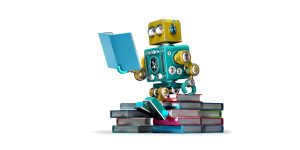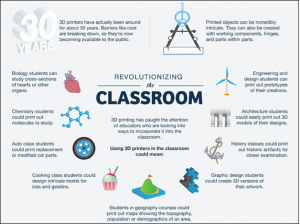
 Data Structure
Data Structure Networking
Networking RDBMS
RDBMS Operating System
Operating System Java
Java MS Excel
MS Excel iOS
iOS HTML
HTML CSS
CSS Android
Android Python
Python C Programming
C Programming C++
C++ C#
C# MongoDB
MongoDB MySQL
MySQL Javascript
Javascript PHP
PHP
- Selected Reading
- UPSC IAS Exams Notes
- Developer's Best Practices
- Questions and Answers
- Effective Resume Writing
- HR Interview Questions
- Computer Glossary
- Who is Who
How 3D Printing Technology is Helping Education Industry?
3D printing technology has been redefining how education is given. Educational institutions have been evolving from traditional methodologies like books, practical classes and field visits to something that students find exciting. It is not that traditional methods are being shunned. Probably the biggest contribution of 3D printing so far has been – How the students have been able to bring to fruition their learning and ideas. For example, it is an exciting proposition for a student to design how a house would look like and actually produce a 3D model.
The tremendous demand for 3D printing from the education industry has driven the growth of 3D software applications specifically aimed at educational institutions. Still, the growth is at the nascent stage.
How does Learning take place now?

Some exceptions barring, students are programmed to consume huge information throughout their student life and expected to apply their learning after the culmination of their academic life. Although it can be argued that students are given practical sessions where they apply their lessons, such arguments are weak because the lessons are quite different from real life and students can barely learn anything.
Current education system may be good for students from a theoretical point of view, but from the perspective of creativity and making, the students are not getting much. It is safe to say that, the whole emphasis is on theory, practical sessions, and interactions. Students tend to experience creative impulses and even question theory but they are not provided with opportunities to test their learning in real-life situations.
So, it can be safely said that students are consumers and not makers.
Impact of 3D Printing Technology on Education Industry
The most significant influence will be the metamorphosis of students from consumers to makers. Students will learn through trials and errors and the most exciting part is they are able to put their ideas and learning to practical applications and see their ideas take shape. The impact of 3D printing technology on education is discussed below.

From Consumers to Makers
As discussed earlier in this article, the current education system largely produces students who are consumers and not makers. Students barely have opportunities to bring to fruition their ideas and creative impulses. 3D printing can potentially turn consumers to makers. It can be a fun and exciting experience. In the Northern New York Robotics Academy, the students are using the 3D printer to design and create Mars rovers, shape settler living quarters and build water supply resources. According to James Carroll, the founder of the academy, “The application of this technology is only limited by the ambition of the teacher and creativity of the students — and there’s no cap on either of those things here.”
Affordable Technology
3D printing technology comes at affordable prices for educational institutions. For example, a single RepRap printer costs about $1200. The great news is according to a study by the Michigan Technological University, educational institutions can cut costs by 97% by replacing their laboratory equipment with those designed for 3D printers.
More Room for Trials and Errors
Trial and errors are an important part of any learning process. While designing and creating on 3D printers, students are expected to come across a lot of trials and errors which require customizations and modifications. Standard technology leaves limited room for experimentation because they are expensive. 3D printers allow students to learn by making errors and learning from them. Designing and creating are a way economical than that in standard technology. That way, 3D printing provides more incentives for learning.

Better Learning
3D printing allows students to have greater exposure to the design and manufacturing process from the start. Since the technology is relatively cheaper than standard technology, there is scope for experimentation without worrying about costs. It fosters creativity and students tend to learn more by doing then just by rote.
Balanced Curriculum
3D printing technology can potentially lead to redefining of the curriculum at many educational institutions. Institutions, when they realize the benefits of 3D technology can balance their curriculum with both theory and real-life applications. Students will have a solid theoretical grounding as well as practical exposure because of such curriculum.
Some Case Studies
There are several case studies that demonstrate the uniqueness and effectiveness of 3D printing technology, as far as education is concerned. A couple of examples are narrated below.
The Edu Tech 3D Challenge, conducted by the Edu Tech Academic Solutions, is a competition where kids create and find out more about their creative talents. Kids are encouraged to submit their top designs and potentially win a MakerBot Replicator 2 3D printing unit for their school.
The e-NABLE project started with a noble aim and has prospered since its beginning. Its main aim is to help people who have become physically challenged. The project started with the making of mechanical prosthetic hand for a young boy. Since then, the project has spread all over the world with people helping people they have never met or known. For example, high school students from the Ben Barber Career and Technology Academy in Texas have been involved in a project to create a 3D-printed hand for Jayme Sims, a man who lost four fingers in his hand due to an accident. The prosthetic was based on the original e-NABLE project design and at $50, it was an economic deal.
Conclusion
There is no doubt that 3D printing can revolutionize education as it proliferates. However, the path is not without challenges. The propagation of 3D printing as an educational tool is so far confined to only some individual or group initiatives and cannot be called an institutional initiative. There are questions on from where is the initiative going to come before universities and governments start to treat this as an important part of the curriculum. That is important considering the strength of funding and institutional support. The groups or individuals involved in 3D printing projects need to demonstrate some really strong use cases to showcase the benefit of the technology.

